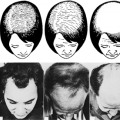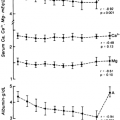While under general endotracheal anesthesia, the patient is placed in a supine position with the neck extended. A low collar incision is made and is carried down through the subcutaneous tissue and platysma muscle. Superior and inferior flaps are developed, and the strap muscles are divided vertically in the midline and retracted laterally.
The thyroid lobe is bluntly dissected free from its investing fascia and rotated medially. The thyroid isthmus is often divided early in the dissection. The middle thyroid vein is ligated. The superior pole of the thyroid is dissected free, and care is taken to identify and preserve the external branch of the superior laryngeal nerve (Fig. 44-1). The superior pole vessels are ligated adjacent to the thyroid lobe, rather than cephalad
to it, to prevent damage to this nerve. The inferior thyroid artery and recurrent laryngeal nerve are identified. To preserve the blood supply to the parathyroid glands, the inferior thyroid artery should not be ligated laterally; rather, its branches should be ligated individually on the capsule of the lobe after they have supplied the parathyroid glands (Fig. 44-2). The parathyroid glands are identified and an attempt is made to leave each with an adequate blood supply. Any parathyroid gland that appears to be devascularized can be minced and implanted into the sternocleidomastoid muscle after its identification by frozen section. Care is taken to identify the recurrent laryngeal nerve along its entire course if a total lobectomy is to be done. The nerve is gently unroofed from surrounding tissue so that trauma to it is avoided. The nerve is in greatest danger near the junction of the trachea with the larynx, because here it is adjacent to the thyroid gland. Once the nerve and parathyroid glands have been identified and preserved, the thyroid lobe can be removed from its tracheal attachments (ligament of Berry). The contralateral thyroid lobe is removed in a similar manner when a total thyroidectomy is performed. A near-total thyroidectomy means that a small amount of thyroid tissue is left on the contralateral side to protect the parathyroid glands and recurrent nerve.38,39 Careful hemostasis and visualization of all important anatomic structures are mandatory for success. The strap muscles are approximated in the midline with only one suture to decrease the possibility of a hematoma in this deep space, which could result in tracheal compression. Several deep dermal sutures of 4-0 absorbable sutures are used. The dermis is approximated by a subcuticular stitch of interrupted 5-0 synthetic absorbable sutures, and the skin edges are approximated with sterile paper tapes. A small suction catheter is often inserted through a stab wound and is usually removed by the following morning.
to it, to prevent damage to this nerve. The inferior thyroid artery and recurrent laryngeal nerve are identified. To preserve the blood supply to the parathyroid glands, the inferior thyroid artery should not be ligated laterally; rather, its branches should be ligated individually on the capsule of the lobe after they have supplied the parathyroid glands (Fig. 44-2). The parathyroid glands are identified and an attempt is made to leave each with an adequate blood supply. Any parathyroid gland that appears to be devascularized can be minced and implanted into the sternocleidomastoid muscle after its identification by frozen section. Care is taken to identify the recurrent laryngeal nerve along its entire course if a total lobectomy is to be done. The nerve is gently unroofed from surrounding tissue so that trauma to it is avoided. The nerve is in greatest danger near the junction of the trachea with the larynx, because here it is adjacent to the thyroid gland. Once the nerve and parathyroid glands have been identified and preserved, the thyroid lobe can be removed from its tracheal attachments (ligament of Berry). The contralateral thyroid lobe is removed in a similar manner when a total thyroidectomy is performed. A near-total thyroidectomy means that a small amount of thyroid tissue is left on the contralateral side to protect the parathyroid glands and recurrent nerve.38,39 Careful hemostasis and visualization of all important anatomic structures are mandatory for success. The strap muscles are approximated in the midline with only one suture to decrease the possibility of a hematoma in this deep space, which could result in tracheal compression. Several deep dermal sutures of 4-0 absorbable sutures are used. The dermis is approximated by a subcuticular stitch of interrupted 5-0 synthetic absorbable sutures, and the skin edges are approximated with sterile paper tapes. A small suction catheter is often inserted through a stab wound and is usually removed by the following morning.
Stay updated, free articles. Join our Telegram channel

Full access? Get Clinical Tree





